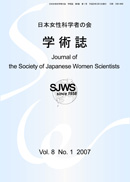Volume 8, Issue 1
Displaying 1-7 of 7 articles from this issue
- |<
- <
- 1
- >
- >|
Review
-
Article type: Review
2007 Volume 8 Issue 1 Pages 1-12
Published: 2007
Released on J-STAGE: October 13, 2011
Download PDF (746K) -
Article type: Review
2007 Volume 8 Issue 1 Pages 13-18
Published: 2007
Released on J-STAGE: October 13, 2011
Download PDF (2638K) -
Article type: Review
2007 Volume 8 Issue 1 Pages 19-25
Published: 2007
Released on J-STAGE: October 13, 2011
Download PDF (1285K)
Original Paper
-
Article type: Original Paper
2007 Volume 8 Issue 1 Pages 26-32
Published: 2007
Released on J-STAGE: October 13, 2011
Download PDF (514K)
Case Report
-
Article type: Original Paper
2007 Volume 8 Issue 1 Pages 33-36
Published: 2007
Released on J-STAGE: October 13, 2011
Download PDF (2139K)
Report
-
Article type: Report
2007 Volume 8 Issue 1 Pages 37-42
Published: 2007
Released on J-STAGE: October 13, 2011
Download PDF (3673K)
Report
-
Article type: Report
2007 Volume 8 Issue 1 Pages 43-55
Published: 2007
Released on J-STAGE: October 13, 2011
Download PDF (6643K)
- |<
- <
- 1
- >
- >|
